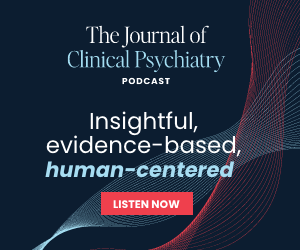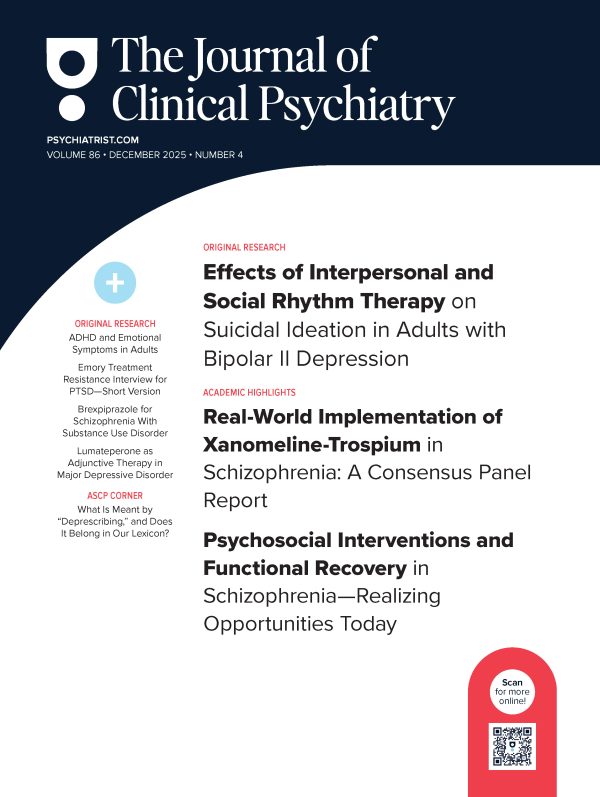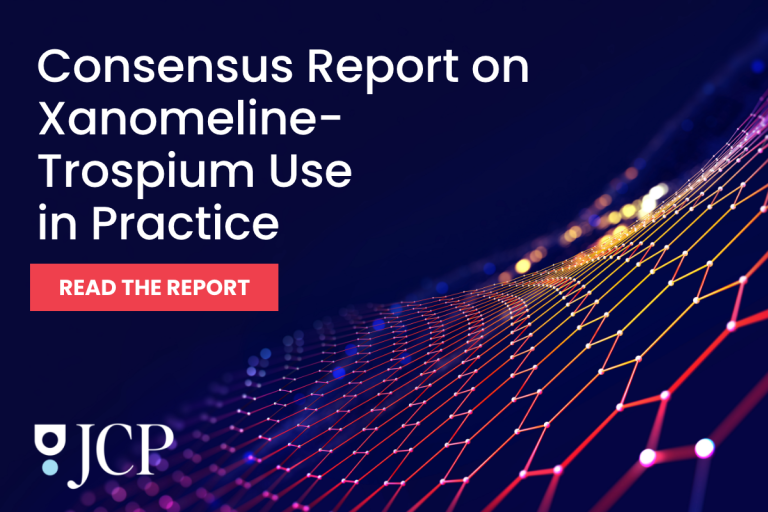ABSTRACT
Objective: Several promising studies investigated marine omega-3 fatty acids (ie, fish oil) in borderline personality disorder (BPD), but overall effects remain unclear. The aim of this study was to obtain estimates of effectiveness of omega-3 fatty acids in BPD using meta-analysis, with a priori differentiation of affective, impulsive, and cognitive-perceptual symptom domains.
Data Sources: We performed a literature search in PubMed, EMBASE, PsycINFO, and MEDLINE, using terms related to BPD and omega-3 fatty acids. Publication date was not a restriction.
Study Selection: We included randomized controlled trials (RCTs) that compared omega-3 fatty acids to placebo or any active comparator and pooled data using meta-analysis. Five studies were included in the meta-analysis, describing 4 RCTs testing effects of omega-3 fatty acids in 137 patients with BPD or BPD-related behavior.
Data Extraction: Using a pre-piloted data extraction form, we obtained data including intervention dose, duration, and BPD symptom scale scores, differentiating affective, impulsive, and cognitive-perceptual symptom domains.
Results: Random effects meta-analysis showed an overall significant decreasing effect of omega-3 fatty acids on overall BPD symptom severity (0.54 standardized difference in means [SDM]; 95% CI = 0.91 to 0.17; Z = 2.87; P = .0041), without heterogeneity (I2 = 0.00; Q = 2.63; P = .45). A priori differentiation of relevant symptom domains showed significant effects on affect dysregulation (0.74 SDM; 95% CI = 1.21 to 0.27; Z = 3.11; P = .002) and impulsive behavior (0.45 SDM; 95% CI = 0.84 to 0.059; Z = 2.26; P = .024). However, effects on cognitive-perceptual symptoms did not reach the significance threshold.
Conclusions: Available data indicate that marine omega-3 fatty acids improve symptoms of BPD, particularly impulsive behavioral dyscontrol and affective dysregulation. Marine omega-3 fatty acids could be considered as add-on therapy.
Members Only Content
This full article is available exclusively to Professional tier members. Subscribe now to unlock the HTML version and gain unlimited access to our entire library plus all PDFs. If you’re already a subscriber, please log in below to continue reading.
References (61)

- Bender DS, Skodol AE. Borderline personality as a self-other representational disturbance. J Pers Disord. 2007;21(5):500–517. PubMed CrossRef
- Pompili M, Girardi P, Ruberto A, et al. Suicide in borderline personality disorder: a meta-analysis. Nord J Psychiatry. 2005;59(5):319–324. PubMed CrossRef
- Hastrup LH, Jennum P, Ibsen R, et al. Societal costs of borderline personality disorders: a matched-controlled nationwide study of patients and spouses. Acta Psychiatr Scand. 2019;140(5):458–467. PubMed CrossRef
- National Collaborating Centre for Mental Health (UK). Borderline Personality Disorder: Treatment and Management. NICE Clinical Guidelines, No. 78. British Psychological Society; 2009.
- Ingenhoven T, Lafay P, Rinne T, et al. Effectiveness of pharmacotherapy for severe personality disorders: meta-analyses of randomized controlled trials. J Clin Psychiatry. 2010;71(1):14–25. PubMed CrossRef
- Soloff PH. Algorithms for pharmacological treatment of personality dimensions: symptom-specific treatments for cognitive-perceptual, affective, and impulsive-behavioral dysregulation. Bull Menninger Clin. 1998;62(2):195–214. PubMed
- Ingenhoven T. Pharmacotherapy for borderline patients: business as usual or by default? J Clin Psychiatry. 2015;76(4):e522–e523. PubMed CrossRef
- Drews E, Fertuck EA, Koenig J, et al. Hypothalamic-pituitary-adrenal axis functioning in borderline personality disorder: a meta-analysis. Neurosci Biobehav Rev. 2019;96:316–334. PubMed CrossRef
- Thomas N, Gurvich C, Hudaib A-R, et al. Systematic review and meta-analysis of basal cortisol levels in borderline personality disorder compared to non-psychiatric controls. Psychoneuroendocrinology. 2019;102:149–157. PubMed CrossRef
- Wingenfeld K, Dettenborn L, Kirschbaum C, et al. Reduced levels of the endocannabinoid arachidonylethanolamide (AEA) in hair in patients with borderline personality disorder—a pilot study. Stress. 2018;21(4):366–369. PubMed CrossRef
- Blaney C, Sommer J, El-Gabalawy R, et al; CIHR Team in Defining the Burden and Managing the Impact of Psychiatric Comorbidity in Immune-Mediated Inflammatory Disease. Incidence and temporal trends of co-occurring personality disorder diagnoses in immune-mediated inflammatory diseases. Epidemiol Psychiatr Sci. 2020;29:e84. PubMed CrossRef
- Díaz-Marsá M, Macdowell KS, Guemes I, et al. Activation of the cholinergic anti-inflammatory system in peripheral blood mononuclear cells from patients with borderline personality disorder. J Psychiatr Res. 2012;46(12):1610–1617. PubMed CrossRef
- MacDowell KS, Marsá MD, Buenache E, et al. Inflammatory and antioxidant pathway dysfunction in borderline personality disorder. Psychiatry Res. 2020;284:112782. PubMed CrossRef
- Anderson G. Pathoetiology and pathophysiology of borderline personality: role of prenatal factors, gut microbiome, mu- and kappa-opioid receptors in amygdala-PFC interactions. Prog Neuropsychopharmacol Biol Psychiatry. 2020;98:109782. PubMed CrossRef
- O’Neill A, Frodl T. Brain structure and function in borderline personality disorder. Brain Struct Funct. 2012;217(4):767–782. PubMed CrossRef
- Mocking RJT, Assies J, Ruhé HG, et al. Focus on fatty acids in the neurometabolic pathophysiology of psychiatric disorders. J Inherit Metab Dis. 2018;41(4):597–611. PubMed CrossRef
- Hibbeln JR, Linnoila M, Umhau JC, et al. Essential fatty acids predict metabolites of serotonin and dopamine in cerebrospinal fluid among healthy control subjects, and early- and late-onset alcoholics. Biol Psychiatry. 1998;44(4):235–242. PubMed CrossRef
- Pawełczyk T, Grancow-Grabka M, Trafalska E, et al. An increase in plasma brain derived neurotrophic factor levels is related to n-3 polyunsaturated fatty acid efficacy in first episode schizophrenia: secondary outcome analysis of the OFFER randomized clinical trial. Psychopharmacology (Berl). 2019;236(9):2811–2822. PubMed CrossRef
- Giacobbe J, Benoiton B, Zunszain P, et al. The anti-inflammatory role of omega-3 polyunsaturated fatty acids metabolites in pre-clinical models of psychiatric, neurodegenerative, and neurological disorders. Front Psychiatry. 2020;11:122. PubMed CrossRef
- Freeman MP, Hibbeln JR, Wisner KL, et al. Omega-3 fatty acids: evidence basis for treatment and future research in psychiatry. J Clin Psychiatry. 2006;67(12):1954–1967. PubMed CrossRef
- Assies J, Pouwer F, Lok A, et al. Plasma and erythrocyte fatty acid patterns in patients with recurrent depression: a matched case-control study. PLoS One. 2010;5(5):e10635. PubMed CrossRef
- Zaalberg A, Vanhouche, A-S, Smoyer A, et al. Voeding En Justitiabelen: Van Strafelement Naar Rehabilitatie-Instrument? Wetenschappelijk Onderzoek- en Documentatiecentrum; 2018.
- Individueel zorgplan en behandeling. In: Depressieve Stoornissen. GGZ Standaarden; 2018. https://www.ggzstandaarden.nl/zorgstandaarden/depressieve-stoornissen/individueel-zorgplan-en-behandeling
- Firth J, Teasdale SB, Allott K, et al. The efficacy and safety of nutrient supplements in the treatment of mental disorders: a meta-review of meta-analyses of randomized controlled trials. World Psychiatry. 2019;18(3):308–324. PubMed CrossRef
- Moher D, Liberati A, Tetzlaff J, et al; PRISMA Group. Preferred reporting items for systematic reviews and meta-analyses: the PRISMA statement. PLoS Med. 2009;6(7):e1000097. PubMed CrossRef
- Stoffers‐Winterling JM, Storebø OJ, Völlm BA, et al. Pharmacological interventions for people with borderline personality disorder. Cochrane Database Syst Rev. 2018(2):CD012956. CrossRef
- Mocking RJ, Harmsen I, Assies J, et al. Meta-analysis and meta-regression of omega-3 polyunsaturated fatty acid supplementation for major depressive disorder. Transl Psychiatry. 2016;6(3):e756. PubMed CrossRef
- Higgins JPT, Altman DG, Gøtzsche PC, et al; Cochrane Bias Methods Group; Cochrane Statistical Methods Group. The Cochrane Collaboration’s tool for assessing risk of bias in randomised trials. BMJ. 2011;343:d5928. PubMed CrossRef
- Guyatt GH, Oxman AD, Schünemann HJ, et al. GRADE guidelines: a new series of articles in The Journal of Clinical Epidemiology. J Clin Epidemiol. 2011;64(4):380–382. PubMed CrossRef
- Upton J. Beck Depression Inventory (BDI). In: Gellman MD, Turner JR, eds. Encyclopedia of Behavioral Medicine. Springer New York; 2013:178–179.
- Gonzalez JS, Shreck E, Batchelder A. Hamilton Rating Scale for Depression (HAM-D). In: Gellman MD, Turner JR, eds. Encyclopedia of Behavioral Medicine. Springer New York; 2013:887–888.
- Coccaro EF. The Overt Aggression Scale Modified (OAS-M) for clinical trials targeting impulsive aggression and intermittent explosive disorder: validity, reliability, and correlates. J Psychiatr Res. 2020;124:50–57. PubMed CrossRef
- Dougherty DM, Marsh DM, Mathias CW. Immediate and delayed memory tasks: a computerized behavioral measure of memory, attention, and impulsivity. Behav Res Methods Instrum Comput. 2002;34(3):391–398. PubMed CrossRef
- Hall RCW, Parks J. The modified global assessment of functioning scale: addendum. Psychosomatics. 1995;36(4):416–417. PubMed CrossRef
- Kay SR, Opler LA, Lindenmayer J-P. The Positive and Negative Syndrome Scale (PANSS): rationale and standardisation. Br J Psychiatry suppl. 1989;155(7):59–67. PubMed CrossRef
- Quilty LC, Robinson JJ, Rolland JP, et al. The structure of the Montgomery-Åsberg Depression Rating Scale over the course of treatment for depression. Int J Methods Psychiatr Res. 2013;22(3):175–184. PubMed CrossRef
- Giesen-Bloo JH, Wachters LM, Schouten E, et al. The Borderline Personality Disorder Severity Index-IV: psychometric evaluation and dimensional structure. Pers Individ Dif. 2010;49(2):136–141. CrossRef
- Maier W, Buller R, Philipp M, et al. The Hamilton Anxiety Scale: reliability, validity and sensitivity to change in anxiety and depressive disorders. J Affect Disord. 1988;14(1):61–68. PubMed CrossRef
- Reise SP, Moore TM, Sabb FW, et al. The Barratt Impulsiveness Scale-11: reassessment of its structure in a community sample. Psychol Assess. 2013;25(2):631–642. PubMed CrossRef
- Sansone RA, Wiederman MW, Sansone LA. The Self-Harm Inventory (SHI): development of a scale for identifying self-destructive behaviors and borderline personality disorder. J Clin Psychol. 1998;54(7):973–983. PubMed CrossRef
- Rybarczyk B. Social and Occupational Functioning Assessment Scale (SOFAS). In: Kreutzer JS, DeLuca J, Caplan B, eds. Encyclopedia of Clinical Neuropsychology. Springer New York; 2011:2313.
- Busner J, Targum SD. The clinical global impressions scale: applying a research tool in clinical practice. Psychiatry (Edgmont). 2007;4(7):28–37. PubMed
- Ingenhoven TJ, Duivenvoorden HJ. Differential effectiveness of antipsychotics in borderline personality disorder: meta-analyses of placebo-controlled, randomized clinical trials on symptomatic outcome domains. J Clin Psychopharmacol. 2011;31(4):489–496. PubMed CrossRef
- Zanarini MC, Frankenburg FR. omega-3 Fatty acid treatment of women with borderline personality disorder: a double-blind, placebo-controlled pilot study. Am J Psychiatry. 2003;160(1):167–169. PubMed CrossRef
- Bellino S, Bozzatello P, Rocca G, et al. Efficacy of omega-3 fatty acids in the treatment of borderline personality disorder: a study of the association with valproic acid. J Psychopharmacol. 2014;28(2):125–132. PubMed CrossRef
- Bozzatello P, Rocca P, Bellino S. Combination of omega-3 fatty acids and valproic acid in treatment of borderline personality disorder: a follow-up study. Clin Drug Investig. 2018;38(4):367–372. PubMed CrossRef
- Hallahan B, Hibbeln JR, Davis JM, et al. Omega-3 fatty acid supplementation in patients with recurrent self-harm: single-centre double-blind randomised controlled trial. Br J Psychiatry. 2007;190(2):118–122. PubMed CrossRef
- Amminger GP, Chanen AM, Ohmann S, et al. Omega-3 fatty acid supplementation in adolescents with borderline personality disorder and ultra-high risk criteria for psychosis: a post hoc subgroup analysis of a double-blind, randomized controlled trial. Can J Psychiatry. 2013;58(7):402–408. PubMed CrossRef
- Buydens-Branchey L, Branchey M. Long-chain n-3 polyunsaturated fatty acids decrease feelings of anger in substance abusers. Psychiatry Res. 2008;157(1–3):95–104. PubMed CrossRef
- Long SJ, Benton D. A double-blind trial of the effect of docosahexaenoic acid and vitamin and mineral supplementation on aggression, impulsivity, and stress. Hum Psychopharmacol. 2013;28(3):238–247. PubMed CrossRef
- Mocking RJT, Steijn K, Roos C, et al. Omega-3 fatty acid supplementation for perinatal depression: a meta-analysis. J Clin Psychiatry. 2020;81(5):19r13106. PubMed CrossRef
- Sutin AR, Milaneschi Y, Cannas A, et al. Impulsivity-related traits are associated with higher white blood cell counts. J Behav Med. 2012;35(6):616–623. PubMed CrossRef
- Sutin AR, Terracciano A, Deiana B, et al. High neuroticism and low conscientiousness are associated with interleukin-6. Psychol Med. 2010;40(9):1485–1493. PubMed CrossRef
- Suchankova P, Holm G, Träskman-Bendz L, et al. The +1444C>T polymorphism in the CRP gene: a study on personality traits and suicidal behaviour. Psychiatr Genet. 2013;23(2):70–76. PubMed CrossRef
- Peet M, Brind J, Ramchand CN, et al. Two double-blind placebo-controlled pilot studies of eicosapentaenoic acid in the treatment of schizophrenia. Schizophr Res. 2001;49(3):243–251. PubMed CrossRef
- Jamilian H, Solhi H, Jamilian M. Randomized, placebo-controlled clinical trial of omega-3 as supplemental treatment in schizophrenia. Glob J Health Sci. 2014;6(7 spec no):103–108. PubMed
- Roberts DJ, Goralski KB. A critical overview of the influence of inflammation and infection on P-glycoprotein expression and activity in the brain. Expert Opin Drug Metab Toxicol. 2008;4(10):1245–1264. PubMed CrossRef
- Wongrattanakamon P, Lee VS, Nimmanpipug P, et al. Nucleotide-binding domain 1 modelling: a novel molecular docking approach for screening of P-glycoprotein inhibitory activity of bioflavonoids. Chemical Data Collections. 2016;2:10–16. CrossRef
- Mollazadeh S, Sahebkar A, Hadizadeh F, et al. Structural and functional aspects of P-glycoprotein and its inhibitors. Life Sci. 2018;214:118–123. PubMed CrossRef
- Wang JS, Taylor R, Ruan Y, et al. Olanzapine penetration into brain is greater in transgenic Abcb1a P-glycoprotein-deficient mice than FVB1 (wild-type) animals. Neuropsychopharmacology. 2004;29(3):551–557. PubMed CrossRef
- El Ela AA, Härtter S, Schmitt U, et al. Identification of P-glycoprotein substrates and inhibitors among psychoactive compounds—implications for pharmacokinetics of selected substrates. J Pharm Pharmacol. 2004;56(8):967–975. PubMed CrossRef



